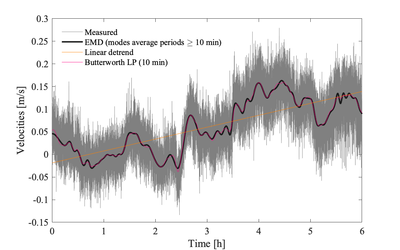Detrending time series
| Short definition of Detrending time series |
|---|
| Detrending typically refers to removing the low-frequency content of the time series |
This is the common definition for Detrending time series, but other definitions maybe discussed within the wiki.
{{#default_form:DefineConcept}} {{#arraymap:Velocity point-measurements, Velocity profilers|,|x||}}
In the context of analysing turbulence observations, the resulting detrended signal should be stationary and contain mostly contributions from turbulence and surface waves (if present). However, frame interference (wakes), vibrations and measurement noise may also contaminate the detrended signal.

There is no exact definition for what consists of a "trend", nor any set algorithm for identifying the trend. The following techniques can be used for detrending [1]:
- Linear trend removal
- Low-pass linear filters
- Empirical modal decomposition
The first two methods presume the original time series is stationary and linear, while the third is adaptive and applicable to nonlinear and non-stationary time series. Note that chopping a time series into smaller subsets, i.e., segments, is essentially a form of low-pass (box-car) filtering.
Notes
- ↑ 1.0 1.1 {{#arraymap:Zhaohua Wu, Norden E. Huang, Steven R. Long, and Chung-Kang Peng|,|x|x|, |and}}. 2007. On the trend, detrending, and variability of nonlinear and nonstationary time series. PNAS. doi:10.1073/pnas.0701020104
